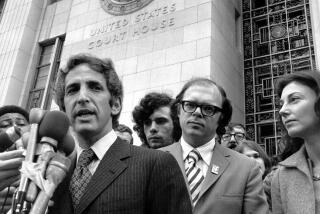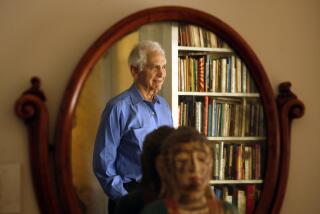William Matthew Byrne Jr., 75; U.S. Judge Presided Over Trial of Pentagon Papers’ Daniel Ellsberg
- Share via
U.S. District Judge William Matthew Byrne Jr., a leading jurist and an ambassador of the law best known for his role in ending the trial of Pentagon Papers defendant Daniel Ellsberg after disclosing government misconduct in the case, died of pulmonary fibrosis Thursday at his Los Feliz home. He was 75.
Byrne became the youngest judge ever appointed to the federal bench when he was confirmed in 1971 at age 40. A member of a prominent legal family, he served from 1994 to 1998 as the Central District’s chief judge, a post once held by his father.
He was known as a formidable settlement judge whose skill at resolving disputes depended as much on his personal charm as on his legal savvy.
“He was a legal giant,” U.S. District Judge Terry J. Hatter Jr., who succeeded Byrne as chief judge, said Friday. “That had much to do with his personality. He was very outgoing.”
“He understood human nature. That’s what made him such a great settler of cases,” said U.S. District Judge Nora Manella.
Byrne traveled around the world to lecture in countries with struggling legal systems, from South America to the former Soviet Union.
“There is no judicial officer I know of who spent more time teaching the rule of law to countries without it than Matt Byrne,” said Ronald L. Olson, a senior partner at the law firm Munger, Tolles & Olson, who knew Byrne for more than 30 years.
Born in East Los Angeles on Sept. 30, 1930, Byrne attended Loyola High School and USC, where he earned a bachelor’s degree in 1953 and a law degree in 1956. His father, William M. Byrne, had been a prizefighter, union organizer and state legislator before joining the federal bench in 1951.
He served as a judge advocate in the U.S. Air Force from 1956 to 1958 before becoming a federal prosecutor in Los Angeles.
He spent several years in private practice as a civil litigator before President Johnson appointed him U.S. attorney in Los Angeles in 1967. By 1969, his office had a 96% success rate in criminal prosecutions, the highest in the country.
President Nixon later named him to head the Commission on Campus Unrest, which issued a report in 1971 that examined the factors behind the explosive student protests of the Vietnam War era. Nixon subsequently appointed Byrne to the U.S. District Court.
During more than 30 years on the federal bench, Byrne handled a number of high-profile cases, including the “Diamond Lane Case” in 1976, in which he ordered the California Highway Patrol not to enforce the newly created high-occupancy lane restriction on the Santa Monica Freeway.
But he was best known for a case that landed in his courtroom barely two years after he arrived on the federal bench: the Pentagon Papers case in 1973.
Ellsberg was the former defense analyst whose unauthorized release of a top-secret history of the Vietnam War set off 1st Amendment court battles and ultimately doomed the Nixon presidency.
After large portions of the so-called Pentagon Papers were published in the New York Times and other newspapers, Ellsberg was indicted on 12 federal counts, including conspiracy, theft of government property and espionage.
As was later revealed in the infamous Oval Office tapes, Nixon was so upset by the media’s heroic portrayal of Ellsberg that he ordered his top aides to dig up incriminating personal information to smear his reputation. “Don’t worry about his trial,” Nixon told then-Atty. Gen. John Mitchell. “Just get everything out.... We want to destroy him in the press.”
A clandestine White House unit led by G. Gordon Liddy and Howard Hunt broke into the Beverly Hills offices of Dr. Lewis Fielding, Ellsberg’s psychiatrist, on Sept. 3, 1971.
They found nothing useful and were not apprehended until after the break-in at the Democratic National Committee headquarters at the Watergate complex in Washington, D.C., nine months later.
In the midst of Ellsberg’s trial, the case took a number of bizarre twists. The first, on April 26, came in the form of a disclosure by the government prosecutor that White House operatives had burglarized Fielding’s office. That night, Nixon’s two top lieutenants -- John Ehrlichman and H.R. Haldeman -- resigned, along with acting Atty. Gen. Richard Kleindienst. White House counsel John Dean was fired.
A few days later, another disturbing revelation came from the judge himself. Byrne disclosed in court that he had had two recent contacts with Ehrlichman, who had offered him a job: director of the FBI.
The trial was shaken again on May 9, when Byrne learned of yet another impropriety: The FBI had secretly taped telephone conversations between Ellsberg and Morton Halperin, who had supervised the Pentagon Papers study. When the government claimed it had lost all relevant records of the wiretapping, Byrne declared a mistrial, on May 11, 1973.
“The totality of the circumstances of this case, which I have only briefly sketched, offend a sense of justice,” Byrne told the court that day. “The bizarre events have incurably infected the prosecution of this case.”
The courtroom erupted in cheers and applause as Ellsberg was freed.
Although Ehrlichman later testified before the Senate Watergate Committee that Byrne had expressed interest in the FBI job, Byrne insisted that he had told the Nixon aide he could not discuss any job offer while the Ellsberg trial was underway.
Years later, Byrne told a reporter that he was not certain he would have been named FBI director, even though he had been mentioned in news accounts in 1972 as one of several possible successors to J. Edgar Hoover. The post eventually went to Clarence M. Kelley.
“Indeed, he was offered the FBI position at a meeting at the Western White House,” Nixon’s home in San Clemente, said Hatter, who knew Byrne for 40 years. “But he wanted to be a judge and to be a judge the right way. There was just no way he could accept a position offered to him like that.”
Byrne, who never married, is survived by nieces and nephews.
A funeral Mass will be said at 9:30 a.m. Thursday at the Cathedral of Our Lady of the Angels, 555 W. Temple St., Los Angeles. Memorial donations may be sent to Loyola High School, 1901 Venice Blvd., Los Angeles CA 90006.
More to Read
Sign up for Essential California
The most important California stories and recommendations in your inbox every morning.
You may occasionally receive promotional content from the Los Angeles Times.











